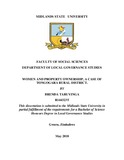Please use this identifier to cite or link to this item:
https://cris.library.msu.ac.zw//handle/11408/3279Full metadata record
| DC Field | Value | Language |
|---|---|---|
| dc.contributor.author | Taruvinga, Brenda | - |
| dc.date.accessioned | 2018-10-31T13:47:46Z | - |
| dc.date.available | 2018-10-31T13:47:46Z | - |
| dc.date.issued | 2018 | - |
| dc.identifier.uri | http://hdl.handle.net/11408/3279 | - |
| dc.description.abstract | The main thrust of the study is to access the relationship between women and property ownership. To bring to light gender inequalities that exists in property ownership and allocation. The research focused on Tongogara Rural District’s ward eight the ward which is poverty prone and one of the causes of poverty being that of lack of property ownership in which affects mostly women. The main aim of the research it to bring to light the disparities in property ownership in Tongogara Rural District, accessing the factors that influences property ownership, examining the barriers to women’s property ownership and suggesting measures that can be taken to alleviate gender inequalities in property ownership and do away with the disparities. The women property ownership issue was contextualized and conceptualized, that is showing the status of women in property ownership worldwide, the factors that influence property ownership and the inequalities and inaccuracies that exist in property allocation and ownership were also discussed. The factors that hinder women to own property and measures that can be taken to do away with the disparities in property ownership have been also discussed. The property inheritance rights were discussed also to shed light on who have rights to property inheritance between females and males whether, daughters, wives, sons and husbands to be able to identify the root cause of disparities in property ownership. Empirical studies were also used to strengthen the study where Nepal was used as a case study and it provided an insight on women and property ownership and also Latin America. As such the study subscribe to a descriptive approach of doing the research where the population size was 77 460 which is comprised of 24 wards, 9 wards from Shurugwi North and 15 wards from Shurugwi South with 24 councilors and 4 chiefs and the. Stratified random sampling and purposive sampling techniques were employed to come up with a total sample of 30 respondents. Stratified sampling was used to come up with three strata of respondents, the community, councilors and chiefs and purposive sampling was used to pick up the chiefs and councilors and the householders. A participatory approach was used in form of focused group discussion which was used to elicit data from householders, and questionnaires were used to the community members and councilors. A total of 25 respondents responded and participated in the study and the data provided is presented in tabulations and narratives. The results of the research reflected that women are being marginalized in property ownership and are being deprived of their rights to own property and that there is gender inequality in property ownership and it reviewed that it is because of variety factors like culture, institutional, legal, patriarchy. The results also reviewed that women in rural areas needs to be educated about their rights so that they will know their entitlements and able to fight for them. It is clear from the research that men dominate in property ownership and there are no effective ways to do away with the inequality and there is need to come up with measures to do away with this disparity in which this research has reflected measures that can be employed so as to create gender equality in property ownership, some measures of which are to enforce laws that has to do with gender equality and the law enforcement should reach rural areas like Tongogara and also to make sure bride price is a two way stream so that men will not view women as their property and women should also occupy high posts in workplace so that they will have access to resources and among others. | en_US |
| dc.language.iso | en | en_US |
| dc.publisher | Midlands State University | en_US |
| dc.subject | Women | en_US |
| dc.subject | Property ownership | en_US |
| dc.title | Women and property ownership: a case study of Tongogara rural district | en_US |
| item.grantfulltext | open | - |
| item.languageiso639-1 | en | - |
| item.fulltext | With Fulltext | - |
| Appears in Collections: | Bsc Local Governance Studies Honours Degree | |
Files in This Item:
| File | Description | Size | Format | |
|---|---|---|---|---|
| brey CHAPTER I.pdf | Full Text | 1.33 MB | Adobe PDF |  View/Open |
Page view(s)
244
checked on Dec 25, 2025
Download(s)
132
checked on Dec 25, 2025
Google ScholarTM
Check
Items in MSUIR are protected by copyright, with all rights reserved, unless otherwise indicated.



